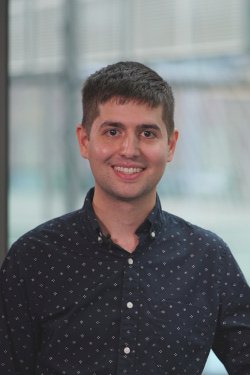Daniel Straus
2021 Regional Award Winner — Post-Doc

Current Position:
Postdoctoral Research Associate
Institution:
Princeton University
Discipline:
Inorganic & Solid-State Chemistry

Current Position:
Postdoctoral Research Associate
Institution:
Princeton University
Discipline:
Inorganic & Solid-State Chemistry
Recognized for: Materials chemist Daniel Straus is challenging assumptions about how materials form and behave, finding new ways to synthesize materials for efficient chemical production and energy generation. Straus identified a structural instability in a promising new solar cell material, known as cesium lead iodide. His discovery lays a foundation for new, stable solar cells to be developed from this material. Straus has also demonstrated a new technique to make chiral, or asymmetric, materials from very simple non-chiral molecules. These chiral materials could be valuable as biological sensors or catalysts for chemical manufacturing.
Areas of Research Interest and Expertise: Materials Chemistry, Physical Chemistry, Inorganic Chemistry, Spectroscopy, Energy Conversion
Previous Positions:
BS, University of Chicago
MS, University of Chicago
PhD, University of Pennsylvania (Advisor: Cherie R. Kagan)
Research Summary:
Daniel Straus, PhD, is discovering new details about the inner workings of materials, providing new pathways to applications ranging from chemical production to energy generation and storage. How a material behaves—whether it is conducting, flexible, or reactive—is determined by its unique microscopic arrangement of atoms. Through advanced characterization techniques, Straus is developing a deep understanding and control of atoms found in promising new materials. One direction of his research is the formation of the material cesium lead iodide (or CsPbI3), which may be used in solar cells. The useful phase of CsPbI3 is unstable at room temperature, and Straus has identified the source: a structural instability where one atom rattles around inside the material. By figuring out what makes CsPbI3 unstable, his work provides a foundation for eventually developing new stable materials that can be incorporated into next-generation solar cells.
Straus is also spearheading efforts to synthesize new chiral materials—materials whose crystal structures are not identical to their mirror images, like the human hand. Just as one can only shake a right hand with another right hand, chiral molecules can preferentially interact with other molecules that match their particular handedness. Because they interact in very selective ways, chiral materials are promising as biosensors or in low-waste chemical manufacturing. Straus has demonstrated a paradigm-shifting new method to make chiral materials out of very simple non-chiral molecules, blazing a path to the synthesis of chiral materials never seen before.
“Many things are known to be impossible, until someone comes along and does them.”
Key Publications:
Other Honors:
| 2019 | John G. Miller Award for Most Outstanding Doctoral Thesis in Chemistry, University of Pennsylvania |
| 2013 | Graduate Research Fellowship, National Science Foundation |
| 2013 | Graduate Student Teaching Award, Department of Chemistry, University of Pennsylvania |
In the Media:
Advanced Science News – Chemists resolve origin of perovskite instability
Princeton – Straus Art Lands on JACS Cover